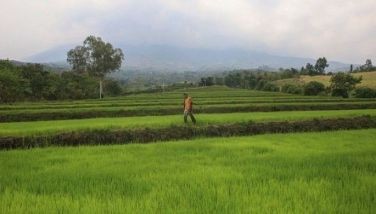Power-generating windmill provides electricity to GenSan folk
SITIO KLOLANG, Barangay San Jose, General Santos City, Philippines – For the longest time, residents of this far-flung village had to regularly negotiate through sharp and dangerous curves for almost an hour to buy essentials such as kerosene and flashlight batteries.
Perched on a mountain range 1,500 meters above sea level overlooking Sarangani Bay, residents had to endure their evenings in pitch darkness.
However, on Tuesday free electricity flowed into this village through a lone power-generating windmill invented by 40-year-old elementary school teacher, William Moraca.
The device, installed by the military on the rooftop of the Klolang Primary School, is now producing more than enough renewable energy to light each of the 40 huts in the village.
Moraca’s invention is connected to a dynamo attached to an alternator that continuously charged the installed 12 volts wet cell batteries which in turn releases 3,000 watts power capacity through a power converter.
A holder of a bachelor degree in elementary education, Moraca’s passion for teaching began three years ago after he resigned from his job as an insurance executive.
“After graduation and passing the teachers’ board, I did not apply for a teaching job but instead went into an insurance business. But when I resigned three years ago and applied for a teaching job, I started to like and love my job,” Moraca, a father of three grown up children, told The STAR in an interview here.
Moraca’s teaching assignment in Barangay San Jose brought him to far-flung villages where his eyes were opened to the sad plight of the marginalized B’laan and T’boli tribesmen.
One of two primary schools now under Moraca’s supervision is the Sitio Klolang Primacy School where school children were deprived of basic needs, like electricity, to help them develop their learning skills while in school or at home.
Moraca finally found ways to improve the lives not only of his wards in school but also the parents as well.
Freedom village
Sitio Klolang, which means “freedom village” in local dialect, will never be the same again.
Aside from the free supply of electricity, residents can also enjoy little amenities that go along with it – a cable television installed by the military’s anti-terror Joint Task Force General Santos City (JTFGSC) headed by Col. Joselito Kakilala.
Kakilala’s unit and its civilian partners in the city have been at the forefront in all of Moraca’s undertakings.
“If there is light, there is life,” said teacher Jacqueline Relacion, referring to the former sleepy village that suddenly came to life last Tuesday following the power switch on ceremony.
Relacion is one of the three female Klolang primary school teachers – the others are Analyn Caneda and Geraldine Yasay -- now under Moraca’s supervision.
The three said that with houses now lighted, the children would have time to study their lessons at home.
The teachers are also keeping their fingers crossed that the cable television will change the outlook of the elders and their subjects on what the real world is like out there.
“Never has this village produced a single college graduate because upon completion of primary or elementary education, most of the female children as young as 13 years old usually get married,” one of the teachers said.
Relacion said she took pity on the schoolchildren because as much as they want it – like their parents before them – they are deprived of the opportunity to explore the lowlands because of abject poverty.
“This is the best gift our village have received so far. Most of the people here have not even gone to the city,” Non Bay, the village chieftain said, referring to the lighting and the television set donated by the Davao-based Eastern Mindanao Command (Eastmincom).
Sneak peek on Pacquiao
Bay also said that he and his constituents have been hearing a lot about Manny Pacquiao but never saw the man in person because most of them have never been to the city proper.
But with an installed cable television, the entire village is now excited to see Pacquiao and watch him fight in Las Vegas on Sunday.
“The village lighting and installation of cable television spread like wildfire to other mountain villages within the area of Mt. Parker,” Moraca said.
Mt. Parker is dormant volcano located within the tri-boundaries of T’boli, General Santos City and Polomolok in South Cotabato.
At least five village chieftains from the inner tribal communities have already asked permission from Bay to be allowed a visit and watch the Pacquiao-Marquez fight.
“Never in my dreams that one day my village will have electricity just like in the lowlands,” Bay said, adding the donated television set now on display in the village’s clearing is an added bonus to all residents.
Through Kakilala, the JTFSC along with other non-government groups like the General Santos City Tennis Club, the city’s business group and the REACT Communication Group of General Santos City among others, partnered with Moraca in his endeavor.
Moraca has been providing the brains while the military and the rest of its civilian partners, the muscle and resources for all his development projects for the indigenous people.
Mobilizing available resources, soldiers started to move all the accessories to Sitio Klolang for the last two weeks by foot or via their four-by-four vehicles.
With everything already in place, Moraca and Kakilala invited local government representatives to witness the “actual switching on” ceremony.
“With his renewable energy invention, lives of people in this community will definitely change,” Kakilala said, adding that it is part of the military’s mandate to combat potential security threats by attacking directly the root causes of insurgency by providing whatever support the far-flung communities need.
Creative thinking
Last month, Moraca’s creativity resulted in the building of a water system for the B’laan tribesmen at the nearby Sitio Datal Salvan.
The invention draws water by means of a magnetic force fan that pumps potable water from a spring 40 feet below the village.
“The residents in the community, including the teachers themselves, are grateful because of the invention they will no longer go down the hilly village to fetch drinking water,” Kakilala said, adding that he is putting up a power-generating windmill at the Task Force headquarters to cut the cost of his camp’s electricity bills.
The only mode of transportation to and from this place, if not by walking, is through a single motorcycle, locally known as “habal-habal.”
Each passenger is charged P10 per ride through the rugged and treacherous terrain.
“Before, we have to go down by foot to the poblacion for our supply of kerosene and batteries for our flashlights. But now, we no longer need a kerosene here as our houses are now lighted,” Bay said.
- Latest
- Trending





























